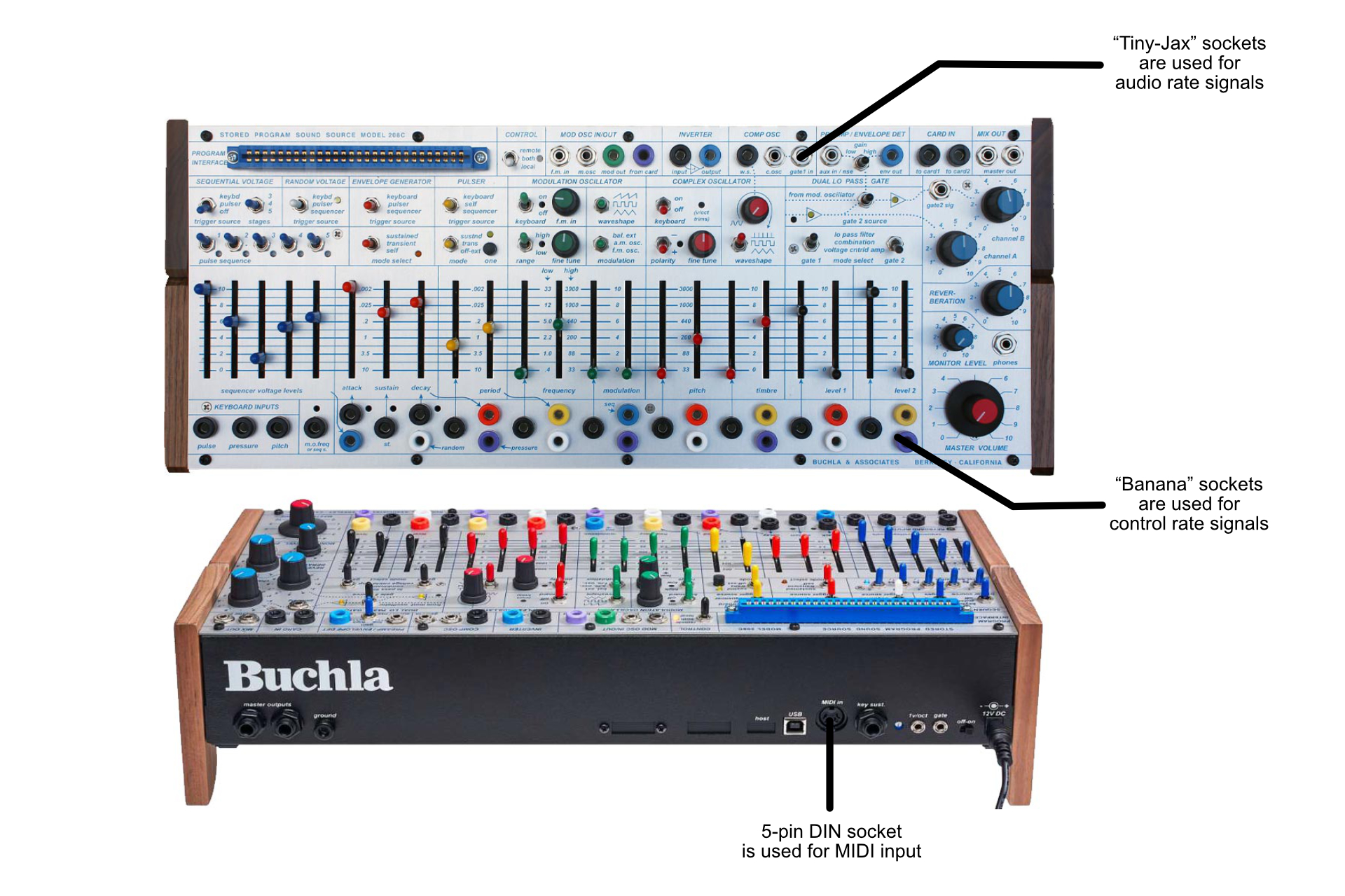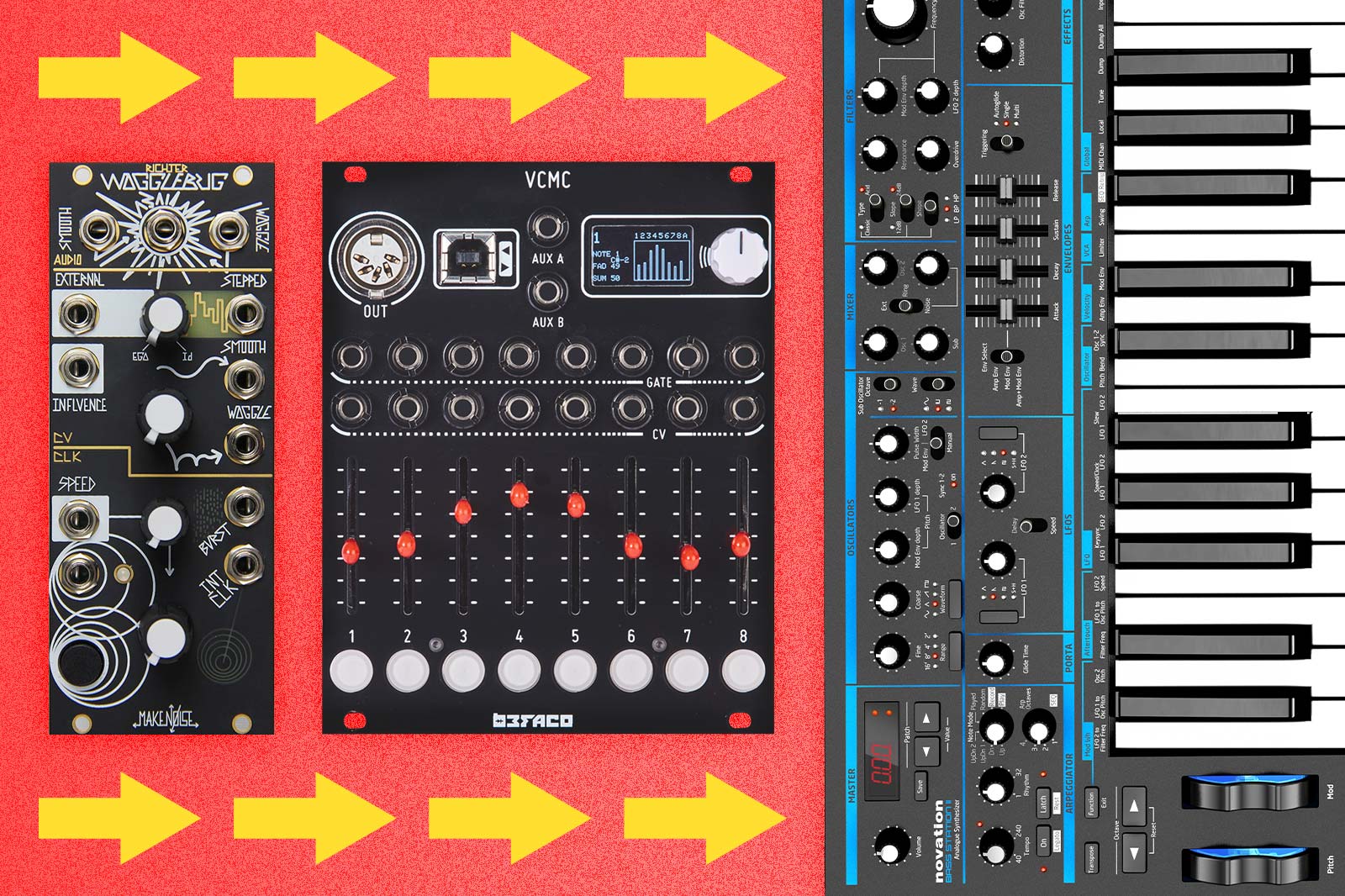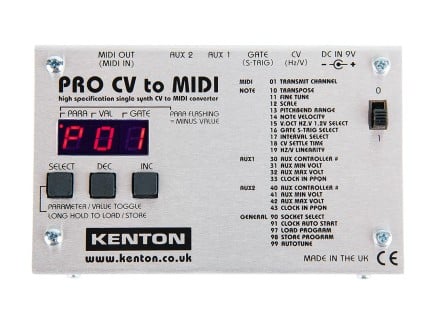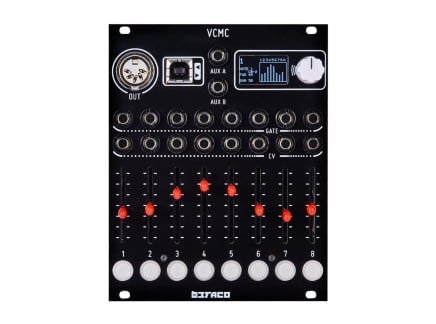If synthesizers have been part of your life for some time, you are most likely familiar with three primary frameworks for controlling these instruments: CV/Gate, MIDI, and OSC. Since these three methods are quite different from each other in application, we often face situations where we have two instruments that are unable to communicate directly, and thus we need a tool that can help us establish the link between them. MIDI is, of course, the most dominant protocol for synthesizer control—it is the "language" spoken by the vast majority of hardware and software released in the last four decades. As far as converters go, it is definitely more common to encounter MIDI-to-CV devices—those that convert MIDI data to analog control voltage signals—since the most typical way of connection goes from MIDI controller to analog synthesizer.
However, there are a number of occasions when you might want to go the opposite direction, and that's where CV-to-MIDI converters come in: they allow you to use your modular synthesizer like an infinitely reconfigurable MIDI controller. But before we get into the weeds of CV-to-MIDI tools and their applications, it may be worth refreshing what different control frameworks are, and how they contrast one another, considering that some of you may be new to the topic or less familiar with one or the other.
The Languages That Synthesizers Speak
CV/Gate is the original method of interacting with analog synthesizers. It works by passing signals of varying voltage level from control modules like an LFO or a keyboard to modulation destinations like oscillator's pitch or filter's cutoff frequency. A Gate signal is a voltage that acts as an on/off switch. It stays high for as long as a key is pressed or as long as defined by a "Gate Length" parameter, and resets to 0V once released. A "Trigger" signal is similar, however it has more of a "pulse"-like nature—it rises to a maximum voltage, and then almost immediately returns to 0V. The key thing to point out here is that only one signal passes through a single cable, hence modular synth patches often look like spaghetti-like sculptures. As a patch grows more intricate (with an increasing number of voices, or increasing number of sonic controls implemented), more and more patch cables are required.
MIDI, on the other hand, is a standardized digital communication protocol introduced in the early 1980s as a method for interconnecting electronic musical instruments and controlling their parameters. It allows you to define a control structure via messages accompanied by integer values that range, for the most part, from 0 to 127. Different kinds of controls have different messages, i.e. if you press a C4 (C3 in some cases) key on a MIDI keyboard, its output will be a "Note On" message with a value of 60 (the note number for C4), as well as "Velocity" message with a value corresponding to how hard you pressed that key. When the key is released, a "Note Off" message is sent out. Turning a knob or a fader generates a "Control Change / Continuous Control" message (or "CC") accompanied by a controller number like "CC4," and a changing value again in the range of 0–127. MIDI is often sent and received via a pair of 5-pin DIN cables for input and output, 3.5mm TRS cables in recent years, or bi-directionally via a single USB cable. A single controller can also output data on up to 16 channels, so a whole system can be easily controlled from a single source with minimum physical connections...unlike with a modular synthesizer, for instance. With MIDI, greater control complexity doesn't necessarily mean that you'll need more cables.
OSC is a networking protocol in some ways similar to MIDI, but with a very different messaging structure. We are not going to get into any details here since it is a bit outside of the topic of this article, but we are mentioning it here as an existing option for synthesizer control, and as you will probably discern as we go on—all of these control frameworks are translatable to one another.
In this article our main goal is to compare the two most prevalent means for controlling electronic musical instruments—MIDI and CV/Gate—and find out what are the best applications for converting analog signals into digital data.
CV vs MIDI
Perhaps it makes sense to start with drawing a comparison between the two control frameworks, as each one has its own set of strengths and weaknesses, and as such, one may be better suitable for some applications then the other.
Let's begin with CV/Gate, as this was the original way to control synthesizers. Needless to say, since it is still widely used today, more than half a century since its introduction, it possesses a number of benefits. Without a doubt, immediacy is on top of that list, as there couldn't be a simpler way to establish a communication between different parts of a synthesizer or even different synthesizers altogether than simply connecting an output of X to an input of Y with a single cable, and zero configuartion. High signal resolution is another major advantage of the analog CV/gate approach, allowing for a great level of accuracy. This is especially noticeable in situations where small increments matter, allowing you to easily fine tune your patches. Finally, the rate at which analog signals can operate is yet another strength, as modulation signals in this realm can run as fast as an audio signal, which is quite essential for many techniques in sound synthesis.
On the other hand, the first clear benefit of MIDI protocol is a combination of streamlined connectivity and vast amount of control. To put it in perspective, a single controller can be set up to control a number of instruments in both hardware and software formats simultaneously. Moreover, because MIDI is a data-based protocol, and because it is so ubiquitous, it can be used not only to control synthesizers and music software but also a variety of non-musical software and hardware, i.e. dedicated VJing software like Resolume or Modul8, lighting fixtures, and even robots.

While MIDI doesn't possess the fluidity of analog signals that can seamlessly transition from control to audio rate, there is something to be said about the benefits of separating audio and control signals. In fact, this was famously a preferred distinction in the work of synthesizer designer / inventor Donald Buchla, in whose systems there is a clear separation between signals used for generating and shaping sound, and those utilized for developing and manipulating musical structures—in Buchla instruments, audio and CV signals use completely different types of jacks (Tini-Jax for audio and banana jacks for CV), and completely different voltage ranges. In a conversation with Jim Aikin (Keyboard magazine, December 1982) Buchla said:
"...Those modules that were designed to operate in the control realm could not operate in the acoustic realm. That's why a multiple arbitrary function generator could be so complex. It didn't have to run at 20kHz. It could operate with times that we perceived as being musically significant, which are perhaps in the millisecond or longer range. Our mixers were designed to operate in the audio domain, and therefore the input controls were exponential. They were AC-coupled, and therefore there were no voltage offsets added when you tried to do FM, for instance. They had 20dB of headroom, which you need when you're dealing with summing audio signals. Whereas a control voltage processor would ideally have linear inputs, would be able to do more complex mathematical things than simply adding signals, and could operate with no headroom at all, because there's no reason for headroom in the control voltage realm. So there are a lot of reasons for separating structure from sound, and these reasons persist as we develop hybrid systems with digital components. We continually have to know whether we're dealing with structure or with sound."
It also has to be mentioned here that although the resolution of many data types in the original MIDI protocol is limited to 128 integer values, we are now at the point where MIDI 2.0 is finally becoming a reality—and this will mean much higher resolution, more channels, and quite a lot of other improvements. As of the moment, not much work has been done to explore these possibilities...but we expect that to change in the near future.
Below are a few snippets from a Vsynth patch modulated via translating CV signals from Wogglebug, and Maths to MIDI CC messages
CV to MIDI Applications
So why would we want to convert a high-resolution control voltage signal to MIDI? Well, there can be a number of reasons that may range from simple and utilitarian to playfully creative. In essence, a CV to MIDI converter is a translator that is helpful in establishing communication between two pieces of equipment that speak different "languages." Let's say you have an analog touch controller such as Random*Source Serge TKB or Make Noise 0-CTRL which are not capable of transmitting or receiving MIDI messages. However, you really want to use them to control your MIDI-only synthesizers like Elektron Digitone, Dreadbox Typhon or maybe even a software instrument of your liking—then a CV-to-MIDI converter is exactly what you need. This is a clear example of practical application of such devices, using the converter to translate modular CV and Gates into Note messages for controlling your MIDI-capable instrument.
The world of Eurorack is also full of unusual probabilistic sequencers, some of which are dedicated trigger sequencers—perfect for integrating with drum machines, and drum synthesizers, especially those that lack a sequencer altogether like Nord Drum 3P, and The Division Department 01/IV but of course not limited to them. Some comprehensive trigger sequencer options in Eurorack are Malekko Varigate 8+, WMD Metron, Erica Synths Drum Sequencer, and Doepfer A-155—each with a unique workflow, and set of features. A great benefit of modular sequencers is that they can be clocked using irregular pulses and random gate bursts, which opens up plenty of creative possibilities for non-linear rhythmic structures and sound design in general.
On a more exploratory side of integrating CV-to-MIDI converters into your workflow, harnessing the complexity and fluidity of control voltage signals that would be difficult to implement with MIDI systems alone is one of the best applications of such tools. For example one can mix a couple of Eurorack LFOs, add a splash of jitter from a noise source, then convert it to a MIDI CC, and voila!—now you are able to manipulate any available parameters in your synth with a new endlessly modifiable modulation source. Another interesting application would be to use a control voltage source like an LFO, sequencer or random voltage source to switch between presets by converting CV to Program Change messages.
Besides letting you inject novel control sources in MIDI systems, conceivably the biggest advantage of adding a CV-to-MIDI converter to your setup is that it essentially expands the toolset of your instrument, and lets you design sounds that were not possible before. With this in mind, it is not a bad idea to put together a dedicated mini system with a CV-to-MIDI converter at the core, a variety of modulation sources, and utilities specifically to spice up your existing setup. In a sense, it is a way to make non-modular instruments modular.
In the images below are patches used for our audio examples
Which CV-to-MIDI Converter Is Best For You
While there are way more options for MIDI-to-CV type modules (the opposite of what we've been describing), the list of CV-to-MIDI converters is certainly growing, and as of today there are a few comprehensive options available both in modular and standalone formats. Which one is best for you largely depends on what you are looking to use it for and with.
A standalone unit like Kenton's Pro CV-to-MIDI Converter is a great option if you are looking for a simple and portable solution that won't take up any space in your rack. It features a Gate, Pitch, and two auxiliary CV inputs that can be mapped to any preferred parameters. Kenton's device is especially handy if you have a collection of synthesizers from different eras and manufacturers as it supports V/octave, Hz/V or 1.2V/oct modes for pitch, and offers an option for Moog's proprietary S-Trig for the Gate input.
Doepfer, the begetter of Eurorack format, also has an offering for this purpose— A-192-2 Dual CV/Gate to Midi/USB Interface. The module is primarily designed to translate the unquantized voltages from analog sequencers into note, velocity, and CC messages. It features two channels of Pitch/Gate/Velocity/CC voltage conversion inputs, making it useful as a rudimentary polyphonic CV to MIDI converter, or to control multiple monophonic instruments on separate MIDI channels. Unique to this module is a separate CV Transpose input that allows you to continuously combine CV going into it with voltage sources entering CVN inputs on each channel for note generation.
While Kenton's and Doepfer's converters are excellent at what they are designed to do, it is quite reasonable that you may want a device with higher input count, and Eurorack format has plenty of options these days. With eight CV and an equal number of Gate inputs, as well as an impressive set of features, Befaco's VCMC (Voltage-Controlled MIDI Controller) module is one of the finest candidates out there. It also features a set of eight mappable faders and buttons, making it effectively not simply a converter, but also a fully-capable controller. Inputs can be used to produce any combination of note data, CCs, program changes, MIDI clock, and much more. Befaco also offers a simplified version of VCMC known as CV Thing which has eight CV/gate inputs but lacks faders, and buttons—an excellent fit for smaller rigs.
ADDAC took a slightly different approach by tackling conversion of control voltage to different types of MIDI messages separately with two dedicated modules— ADDAC222 CV to Notes, and ADDAC221 CV to CC. Such decoupling of note and control data leaves space in the interface to add unique features to the front of the panel for easy access during performance like note transposition, octave switching, and voltage attenuation.
Expert Sleepers FH-2 and General CV modules can also be used for CV-to MIDI conversion. While they don't offer an overwhelming amount of inputs, these modules fall into another category of multipurpose tools where the CV-to-MIDI conversion is yet one more thing these modules can do. FH-2, for instance, is one of the most feature-rich MIDI-to-CV converters, as well as USB MIDI host and device, and a powerful arpeggiator. General CV, on the other hand, primarily is an intricate General MIDI-based sound source with a ton of creative possibilities.
In a similar realm of multi-purpose modules is the Tubbutec's uTune—a bidirectional MIDI-to-CV and CV-to-MIDI converter, microtonal quantizer that reads popular Scala file formats, an arpeggiator, tuner, and VCO calibrator. On top of that, what makes uTune truly amazing is its expandability. Equipped with two CV/Gate channels by default, the channel count on the module can be expanded to up to eight with small dual expander modules—enabling extensive options for interfacing between CV and MIDI-capable devices.
Finally, it is worth mentioning that CV-to-MIDI tools also exist in the software realm. In particular, the free Eurorack emulation software VCV Rack has several options for CV-to-MIDI conversion. To use them with hardware modules it is important to have an interface with DC-coupled inputs like Expert Sleepers ES-8 or ES-9. Alternatively, you'll find a plethora of fun sequencers and modulation modules in VCV rack itself that'll get you going in no time—so if you want a taste of what CV to MIDI conversion can be like, it's quite easy to try out VCV Rack with whatever MIDI-equipped gear is around your studio.
Hopefully this set of options gives you a clearer idea of what you need to look for when selecting a CV-to-MIDI converter for yourself. Some are certainly more extensive in their connectivity options, but that may or may not be the right fit for you. Perhaps a pair of CV/gate inputs will suffice for your purposes, or simply seem particularly exciting from a creative standpoint. Or maybe, as mentioned earlier, you'll decide to design a dedicated "translator" sidecar with a variety of options for creative modulation and conversion. Either way, there are plenty of options available these days, and surely you'll find something that will fit your desired configuration.

















